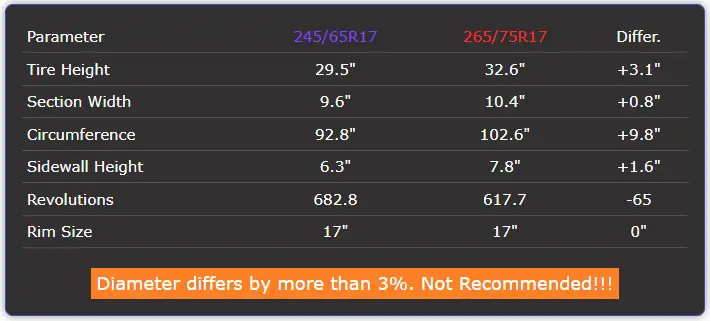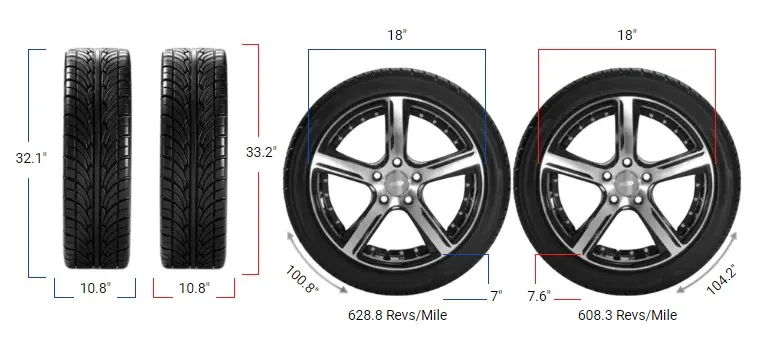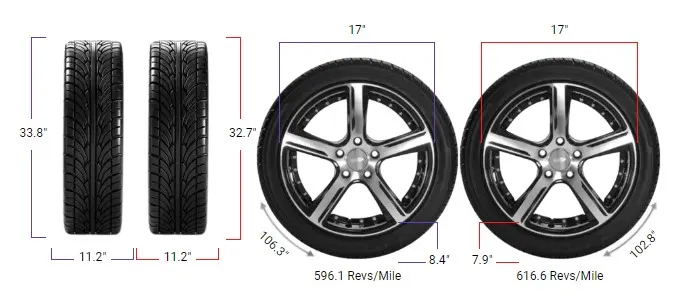Tire Size 245/65r17 vs 245/75r17
 Thinking about changing your tires? Switching from a 245/65r17 to a 245/75r17 might seem simple, but it can have big impacts on your vehicle’s performance. Let’s dive into what this change means for you.
Thinking about changing your tires? Switching from a 245/65r17 to a 245/75r17 might seem simple, but it can have big impacts on your vehicle’s performance. Let’s dive into what this change means for you.
- Increased sidewall height enhances ride comfort over rough terrain.
- The larger tire can improve off-road capability and traction.
- The 245/75R17 may negatively affect fuel efficiency due to increased weight.
- A taller tire can alter speedometer accuracy and performance.
- The same width maintains stability during cornering and handling.
- Fitting the larger tire may require adjustments to wheel wells and suspension.

Fitment Guide
According to the Fitment Guide, when replacing tires, the new tire’s diameter should be within 3% of the original size.
The diameter difference here is 6.5%, exceeding the acceptable range. Therefore, swapping these tires is not recommended unless you make adjustments to prevent issues like rubbing or clearance problems.
On-Road Impact
Changing your tire size can significantly affect how your vehicle performs on everyday roads. Here’s what you need to know about the on-road impacts of switching to a larger tire.

- Ground Clearance: With a larger diameter, your vehicle’s ground clearance increases by about 0.96 inches. This means your car sits higher off the ground, which can help avoid scraping on speed bumps or steep driveways. However, it also raises the vehicle’s center of gravity, which can affect handling and stability, especially during sharp turns.
- Gas Mileage: Larger tires are heavier and can cause your engine to work harder. This extra effort can lead to decreased fuel efficiency. While the difference might not be huge, you may notice a slight drop in miles per gallon over time.
- Aesthetic Look: Bigger tires can give your vehicle a more rugged and aggressive appearance. This might be desirable if you’re going for a tougher look. However, some people might find the larger tires make the vehicle look disproportionate.
- Ride Comfort: The increased sidewall height (a 15.4% increase) means there’s more rubber between the wheel and the road. This can absorb bumps better, leading to a smoother ride on rough or uneven pavement.
- Speedometer Accuracy: Because the larger tires cover more distance with each rotation, your speedometer will read lower than your actual speed. For example, when your speedometer shows 20 mph, you’re actually traveling at 21.31 mph. This difference can lead to unintentional speeding if you’re not careful.
- Durability & Wear: Larger tires may wear differently than smaller ones. The increased sidewall can flex more, potentially leading to increased heat and faster wear if not properly inflated and maintained.
Off-Road Impact
If you enjoy taking your vehicle off-road, changing to larger tires can offer some advantages and challenges. Here’s how the new tire size affects off-road performance.

- Traction: The larger diameter allows the tire to roll over obstacles more easily, improving traction on rough terrain. This can be especially helpful when navigating rocks, mud, or sand.
- Sidewall Flexibility: The taller sidewall can flex more, allowing the tire to conform to uneven surfaces. This can enhance grip and provide a smoother ride over bumps and dips.
- Clearance Issues: The increased size may cause the tires to rub against the wheel wells, suspension components, or fenders when turning or when the suspension compresses. This can lead to damage over time. To prevent this, you might need to modify your vehicle, such as installing a lift kit or adjusting suspension components.
- Vehicle Dynamics: A higher center of gravity can affect the stability of your vehicle on steep inclines or during sudden maneuvers. This could make your vehicle more prone to tipping in extreme conditions.
- Tire Pressure Adjustments: Off-roading often requires adjusting tire pressure for optimal performance. The larger tire may require different pressure settings to perform effectively without risking damage.
245/65r17 vs 245/75r17
This table compares the key features of tire sizes 245/65R17 and 245/75R17.
| Feature | 245/65R17 | 245/75R17 | Difference |
|---|---|---|---|
| Diameter inches (mm) | 29.54 (750.3) | 31.47 (799.3) | 1.93 (49) 6.5% |
| Width inches (mm) | 9.65 (245) | 9.65 (245) | 0 (0) 0% |
| Circumference inches (mm) | 92.8 (2357.14) | 98.86 (2511.08) | 6.06 (153.94) 6.5% |
| Sidewall Height inches (mm) | 6.27 (159.25) | 7.23 (183.75) | 0.96 (24.5) 15.4% |
| Revolutions per mile (km) | 682.75 (424.24) | 640.9 (398.24) | -41.86 (-26.01) -6.1% |
| Speedo Reading | 20 mph (32.19 km/h) | 21.31 mph (34.29 km/h) | +1.31 mph |
Difference Between 245/65R17 and 245/75R17
The main difference is the diameter. The 245/75R17 tire is 1.93 inches taller than the 245/65R17 tire, which impacts ground clearance and overall tire height.
Can I Use 245/75R17 Instead of 245/65R17?
Yes, but the 245/75R17 tire is 6.5% larger in diameter, which may affect speedometer accuracy, handling, and fuel efficiency. Ensure your vehicle can accommodate the larger size before switching.
How Much Taller Is a 245/75R17 Tire Than a 245/65R17?
The 245/75R17 tire is 1.93 inches taller than the 245/65R17 tire, offering more ground clearance and a higher ride height.
Our Observation
Switching from 245/65r17 to 245/75r17 offers some clear benefits, especially for off-road enthusiasts. The increased ground clearance and improved ability to navigate rough terrain can enhance your off-road experience.
On-road, you might appreciate the smoother ride due to the taller sidewalls. However, the 6.5% increase in diameter exceeds the recommended limit, which can cause issues like inaccurate speedometer readings and potential rubbing without proper modifications.
The impact on gas mileage and vehicle handling is noticeable; you may find your vehicle consumes more fuel and feels different when turning or braking.
These changes are significant and shouldn’t be overlooked. If you decide to make the switch, be prepared to make necessary adjustments to your vehicle, such as installing a lift kit or recalibrating the speedometer, to ensure safe and proper operation both on and off the road.



